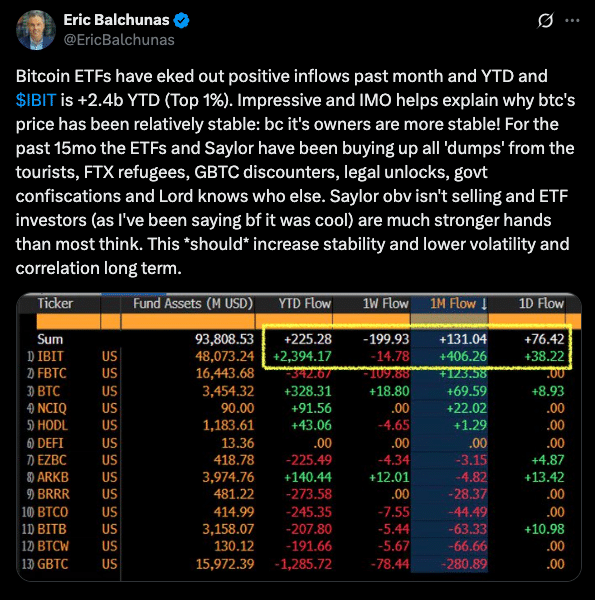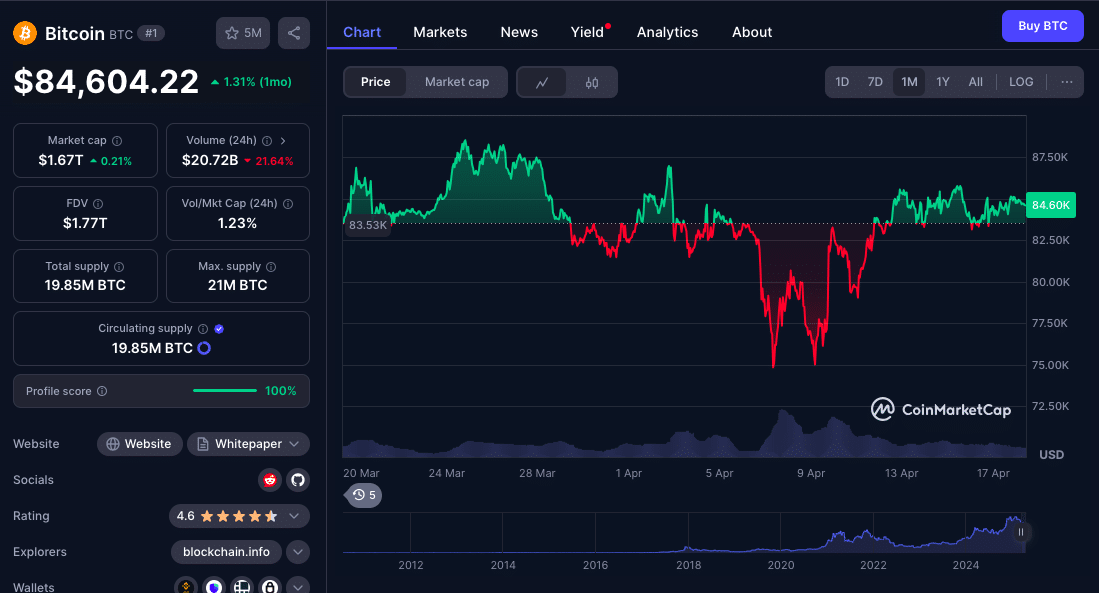As geopolitics and monetary policy uncertainty spook equities and traditional assets, Bitcoin has remained remarkably stable. The leading cryptocurrency has been trading between $75,000 and $88,000 for the past month and is showing signs of decoupling from the volatility that defines the broader markets.
This tranquility, according to Bloomberg ETF analyst Eric Balchunas, is being driven by two unlikely sources: long-term Bitcoin ETF investors and Michael Saylor’s firm, Strategy.
ETF Inflows Signal Conviction, Not Speculation
Eric Balchunas, a leading ETF specialist at Bloomberg, wrote on X on April 16 that Bitcoin’s new price stability is due to ETF investors having “stronger hands than most people think.” While retail traders may have sold into profit-taking or macro jitters, ETF investors have been buying the dip, protecting Bitcoin from deeper drawdowns.
According to Balchunas, spot Bitcoin ETFs have seen $131.04 million in inflows over the last 30 days and $2.4 billion in inflows since January 1. This is not speculation, but conviction. Most of the recent market activity is not being driven by traders, but by people willing to hold through volatility, a big change from past cycles where panic selling dominated corrections.
These investors, Balchunas noted, are absorbing coins being sold by distressed sellers — FTX creditors, GBTC arbitrageurs, and others reacting to unlocks, confiscations and legal outcomes.
“The ETFs and Saylor have been buying up all the dumps from the tourists,” he said, highlighting the change in Bitcoin’s ownership structure.

Saylor Doubles Down with Another $285M Buy
Michael Saylor’s Strategy has been a big part of the institutional narrative around Bitcoin and his firm’s latest move cements that. On April 14, Strategy bought 3,459 BTC for $285.5 million, bringing their total holdings to 531,644 BTC, worth over $44 billion at current prices. That makes Strategy the largest public holder of Bitcoin, now owning over 2.5% of the total supply. Saylor, who has become one of the most vocal Bitcoin proponents, is not bothered by macro or short-term price action.
According to Saylor Tracker, Strategy’s average cost basis is $67,556 per BTC, so even with sideways movement, the unrealized gains are substantial.
This has a psychological impact on markets. Many now view Saylor’s buys as a stabilizing force, effectively capping dips and reinforcing institutional confidence.
Low Volatility Speaks Volumes
According to Bitbo’s Bitcoin Volatility Index, 30-day rolling volatility is 1.80%, the lowest in recent history. For context, during the 2021 bull cycle, volatility was above 4% and even in 2023, it was near 3%.
What’s interesting is that Bitcoin is less volatile than the S&P 500. In a recent report, it was noted that US equities are getting more erratic due to weakening investor confidence and fading hopes of a soft landing for the US economy. Bitcoin is behaving like a digital macro hedge, supported by holders, not speculators.
Even skeptics are noticing. Dividend Hero posted to his 203,000+ followers on April 5, “I’ve hated on Bitcoin in the past but seeing it not tank while the stock market does is very interesting to me”.
Macroeconomic Noise, Steady Price Action
The backdrop to Bitcoin’s steady hand is anything but calm. From Trump’s tariffs to the Fed’s delayed rate cut roadmap, macro uncertainty is high. Yet Bitcoin has not only held above its previous all-time high of $73,679 (first surpassed in November 2024) but has also decoupled from risk assets.
Over the last 30 days, Bitcoin’s price has traded in a range rarely seen in previous bull cycles. Despite threats of new inflationary shocks, global capital flight from US Treasuries and rising systemic risk in emerging markets, Bitcoin’s support zones have held.

Some are now saying Bitcoin is transitioning into a “quasi-sovereign” asset class driven less by retail froth and more by sovereign-level actors, institutions, and regulated financial products like ETFs.
Conclusion: Stronger Hands Are Redefining Bitcoin’s Narrative
Bitcoin ETF investors and long term accumulators like Michael Saylor are not just propping up price action, they’re redefining the very nature of Bitcoin’s market behavior. They’re reducing the volatility, changing the correlation to traditional assets and potentially shifting how financial institutions view its risk profile.
This isn’t just holders vs sellers. It’s a shift of Bitcoin’s core market base from retail-driven boom and bust cycles to institutional-grade long-term investment vehicles. If this continues, the crypto market’s foundational asset may no longer be its most volatile. It may instead be its most stable.
FAQs
What do Bitcoin ETF investors do to ensure price stability?
ETF investors hold through volatility, absorb sell-offs, and dampen price swings.
How much Bitcoin does Michael Saylor’s Strategy hold?
As of April 2025 Strategy holds 531,644 BTC, worth over $44 billion.
Why is Bitcoin less volatile now?
Long-term holders like ETF participants and institutions reduce market churn; macroeconomic decoupling also plays a role.
Has Bitcoin outperformed the stock market recently?
Yes. While the S&P 500 is more volatile, Bitcoin is steady, above previous highs.
Is Bitcoin a Safe haven asset?
Still early days but it looks like Bitcoin is being seen as a hedge by some investors in macro uncertainty.
Glossary
Bitcoin ETF – A financial product that lets you get exposure to Bitcoin without owning it directly, traded on traditional exchanges.
Volatility Index – A statistical measure of the dispersion of returns for an asset, to measure how stable or unstable its price is over time.
Saylor Tracker – A platform that tracks all of Michael Saylor’s and Strategy’s Bitcoin holdings and buys.
Spot ETF – An ETF backed by the actual asset (in this case, Bitcoin), not derivatives or futures.
References
Michael Saylor’s official X post
Disclaimer: This is for ‘informational purposes only and not financial advice. Cryptocurrency investments are risky and subject to regulatory changes. Always consult a financial advisor before investing.



















































































































